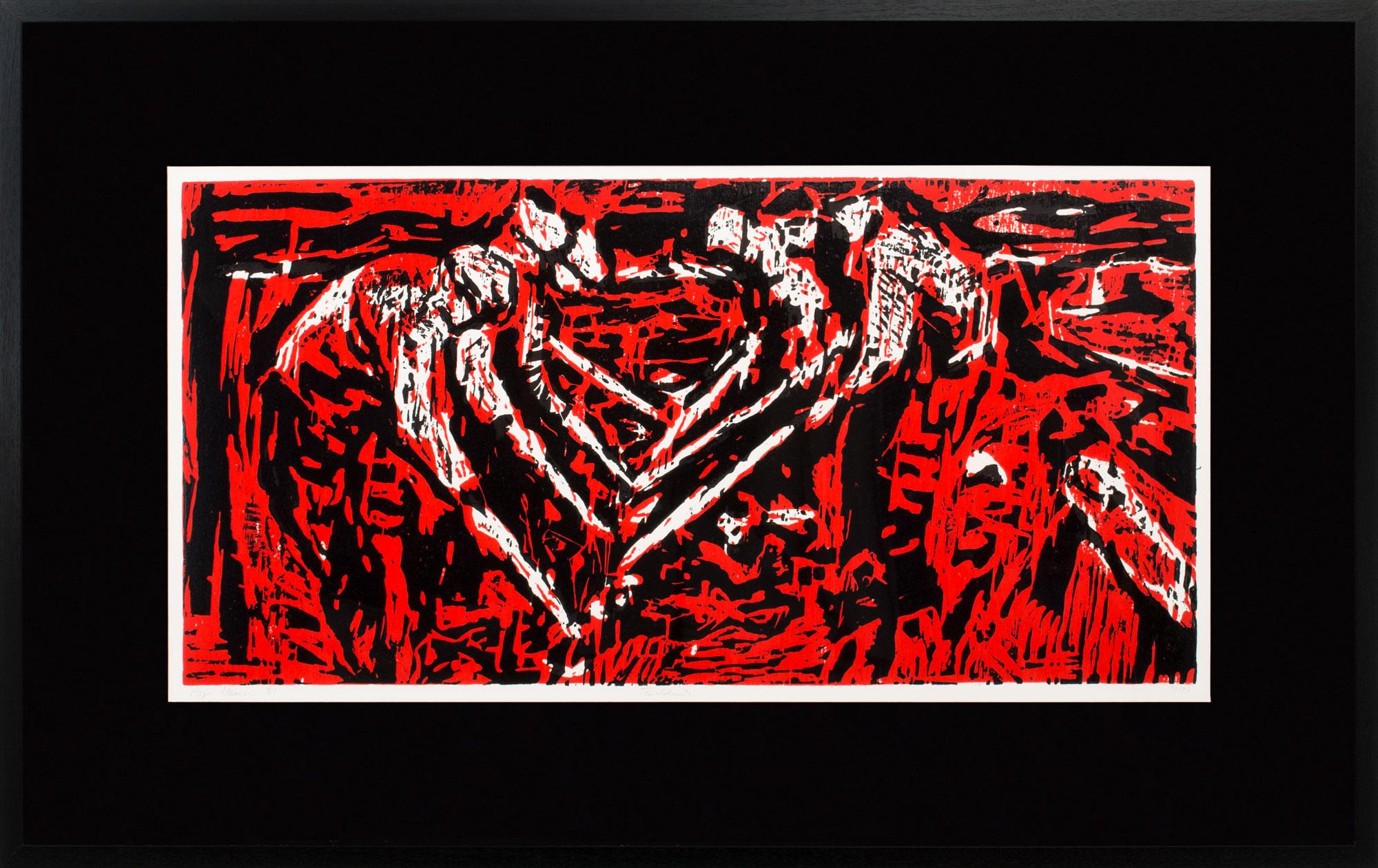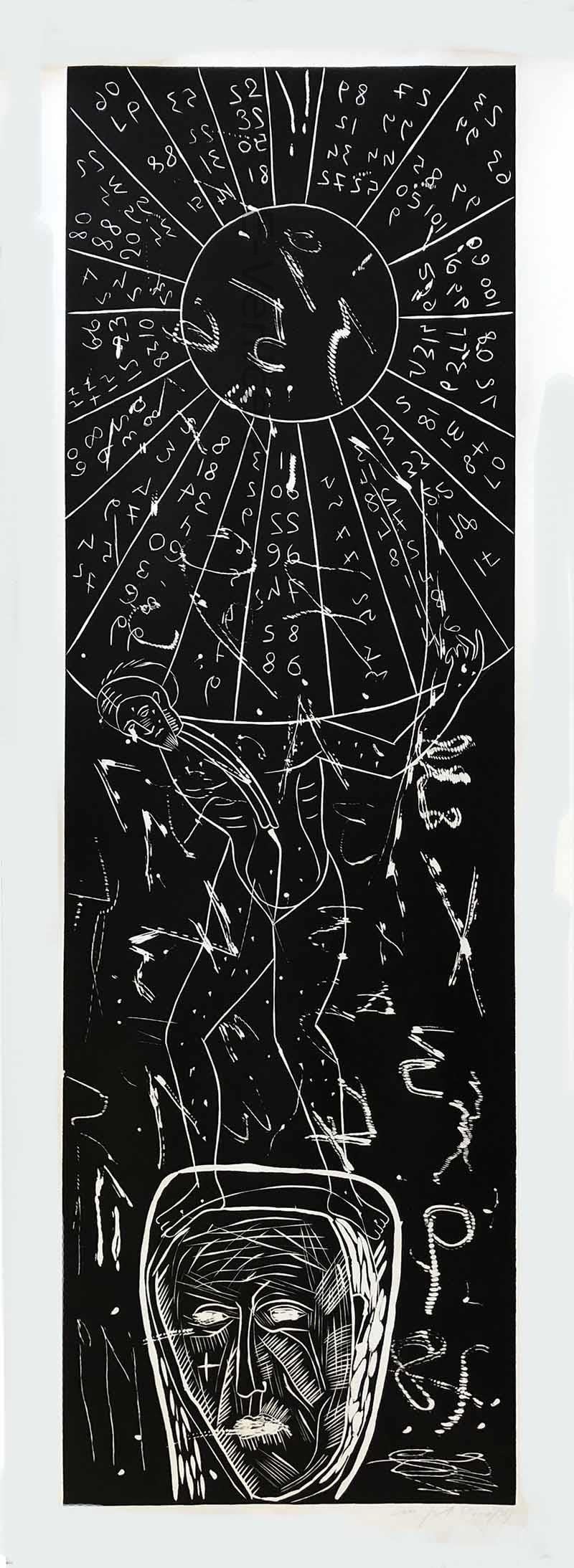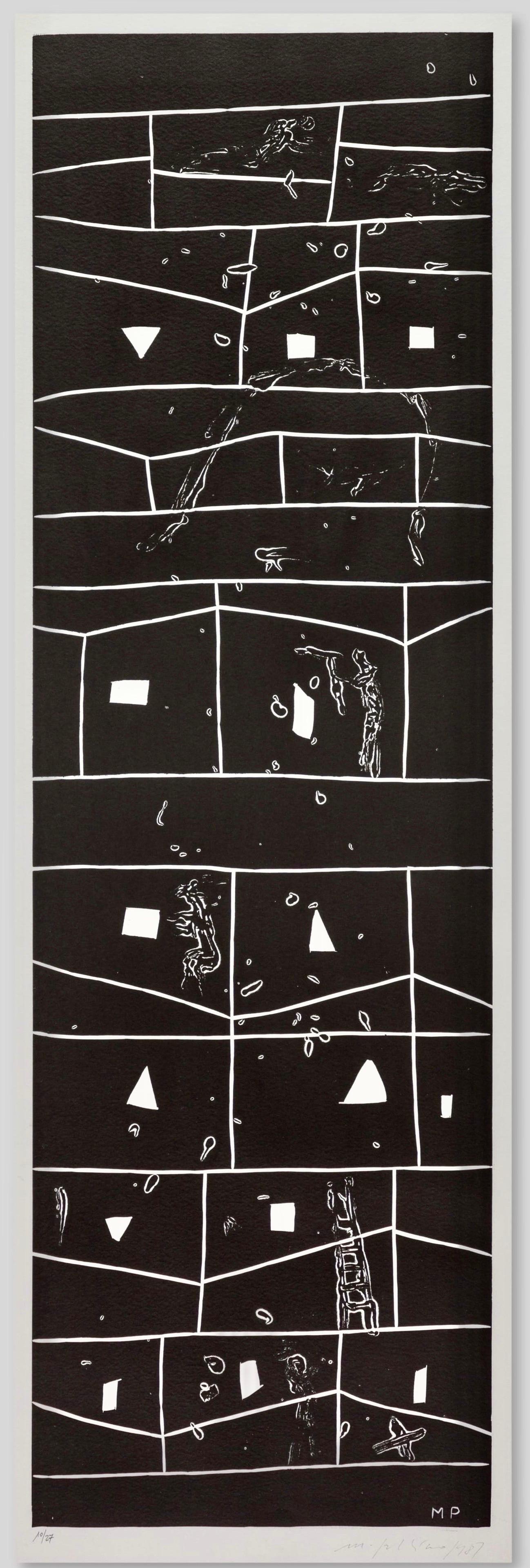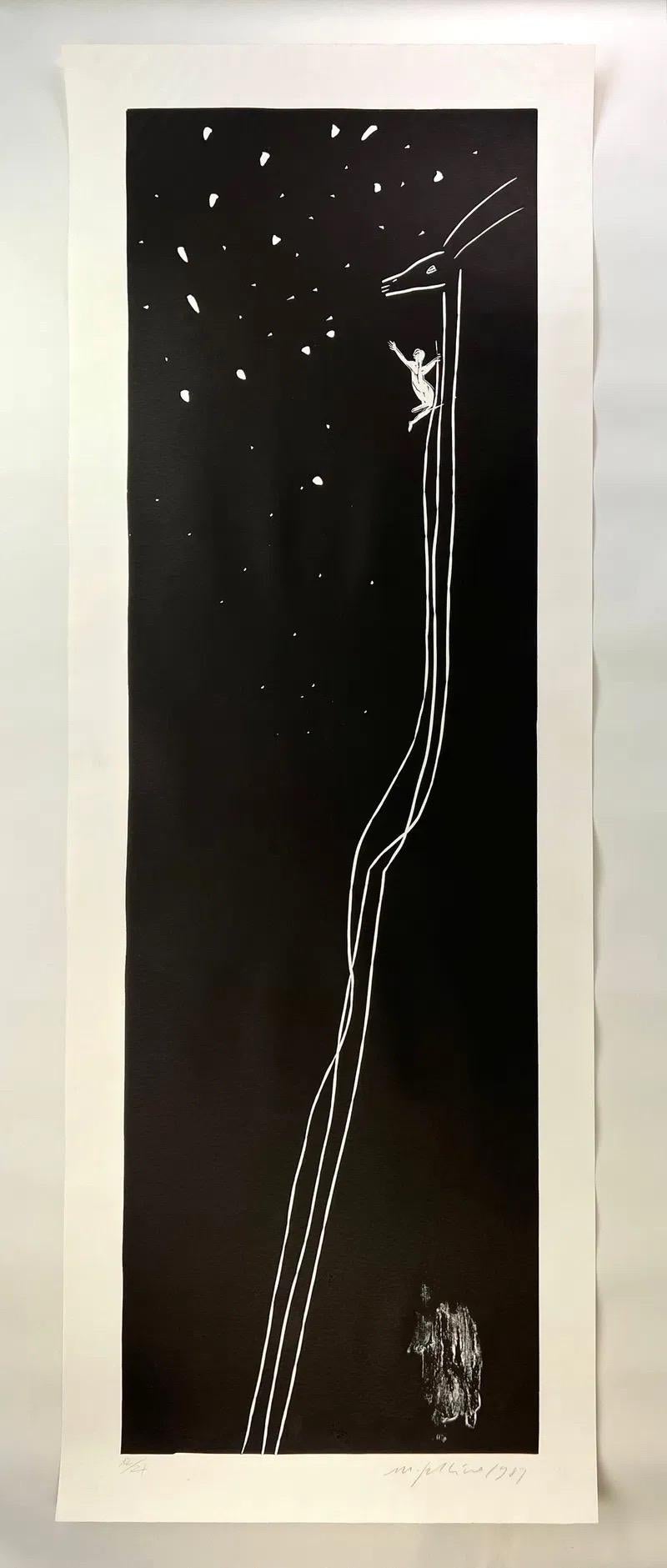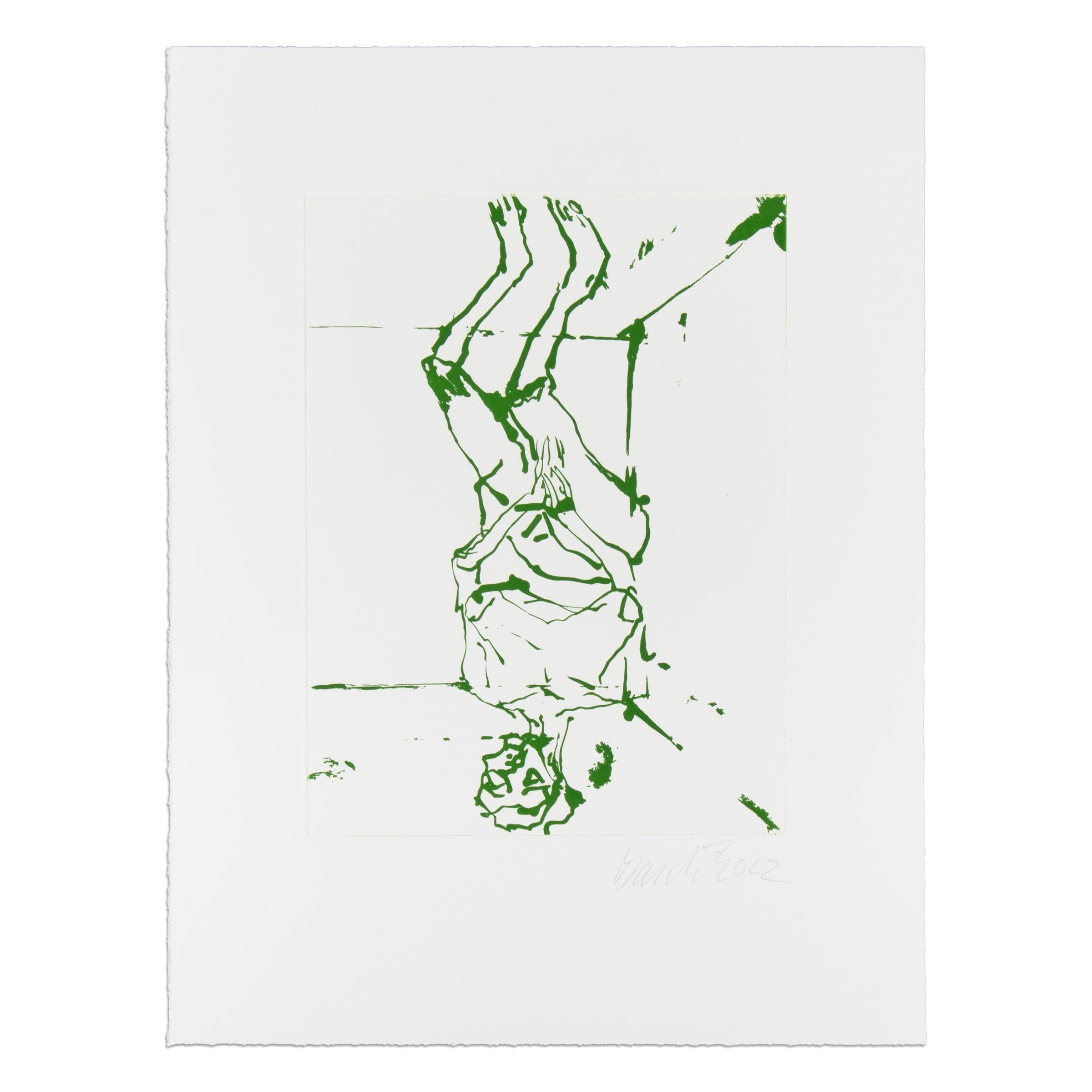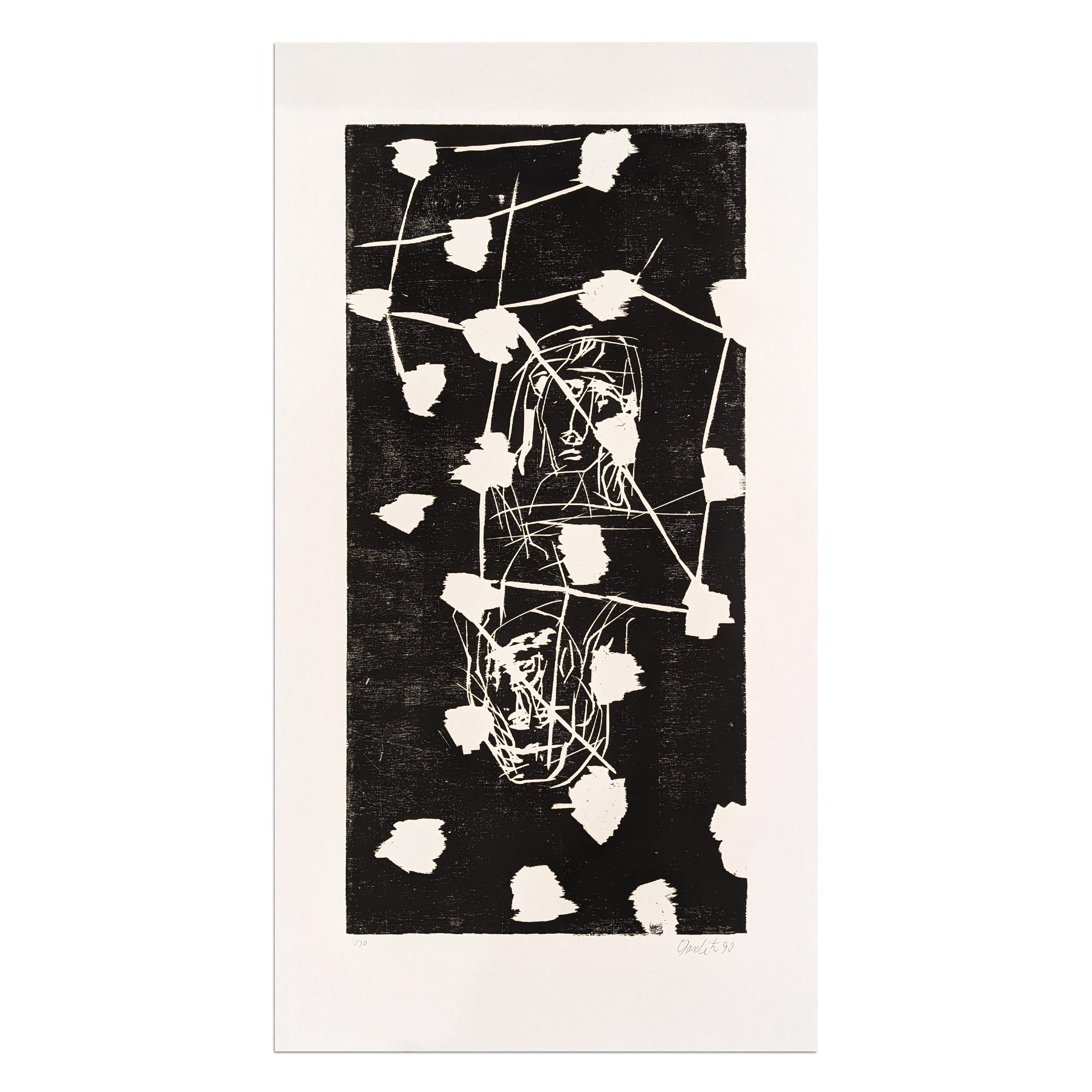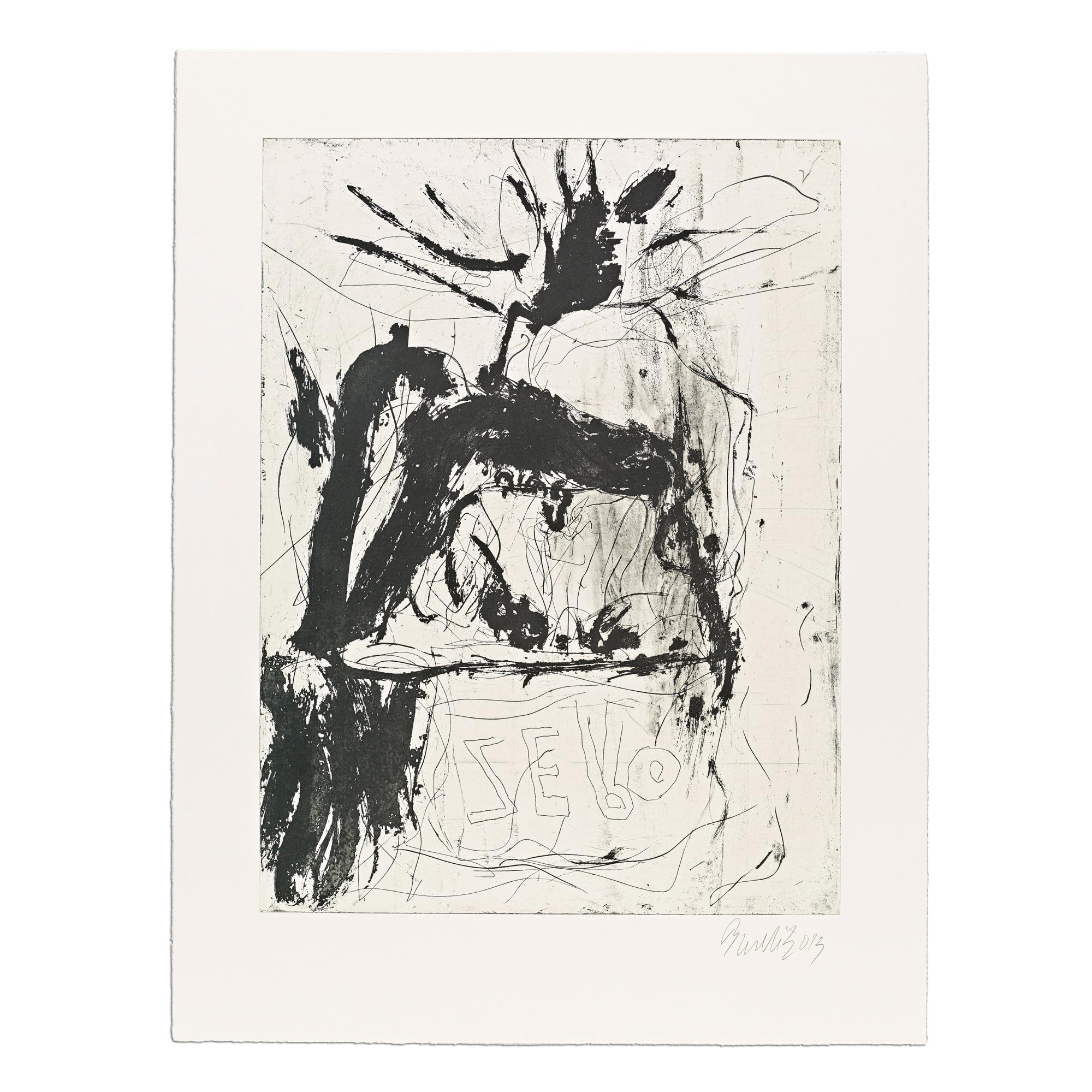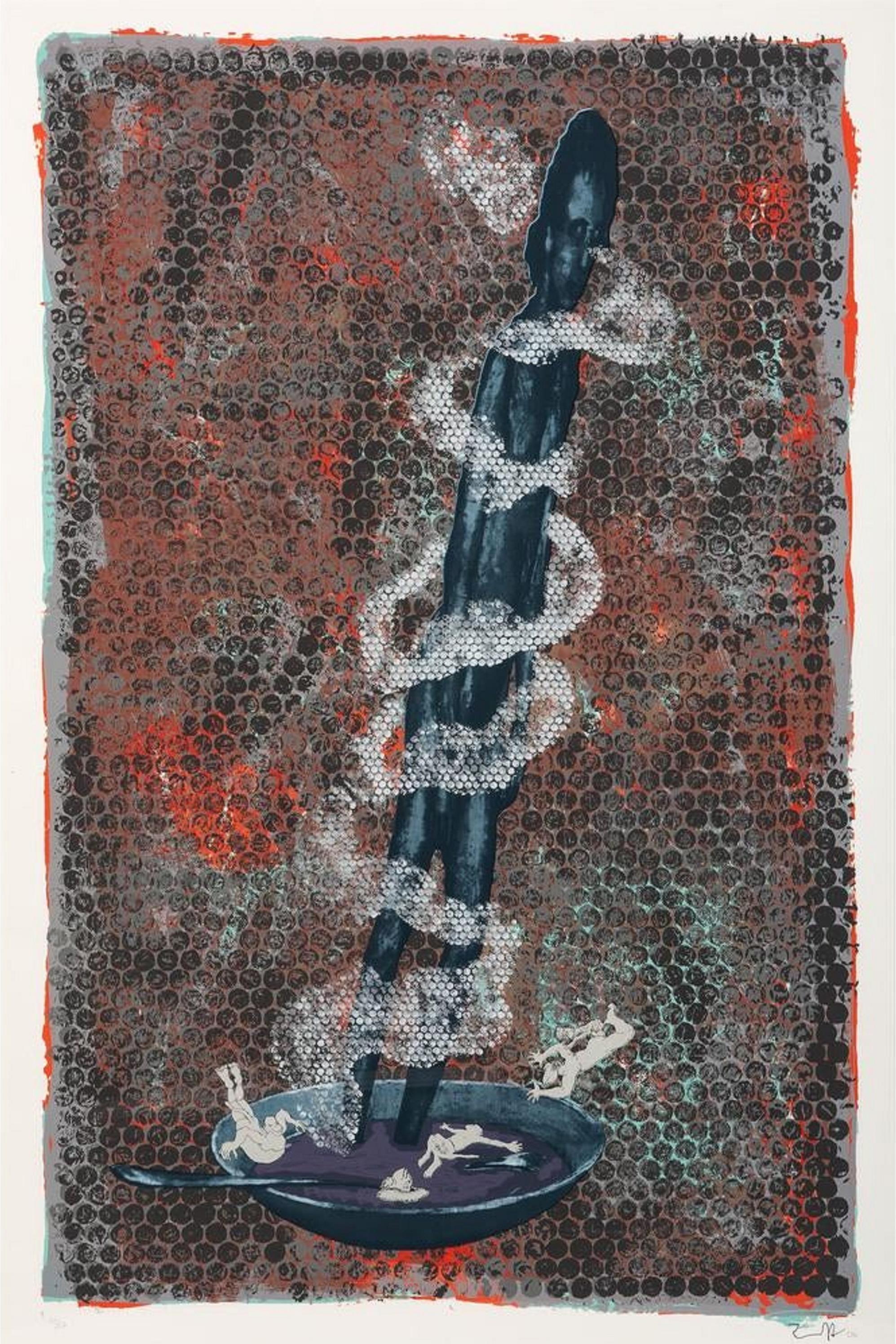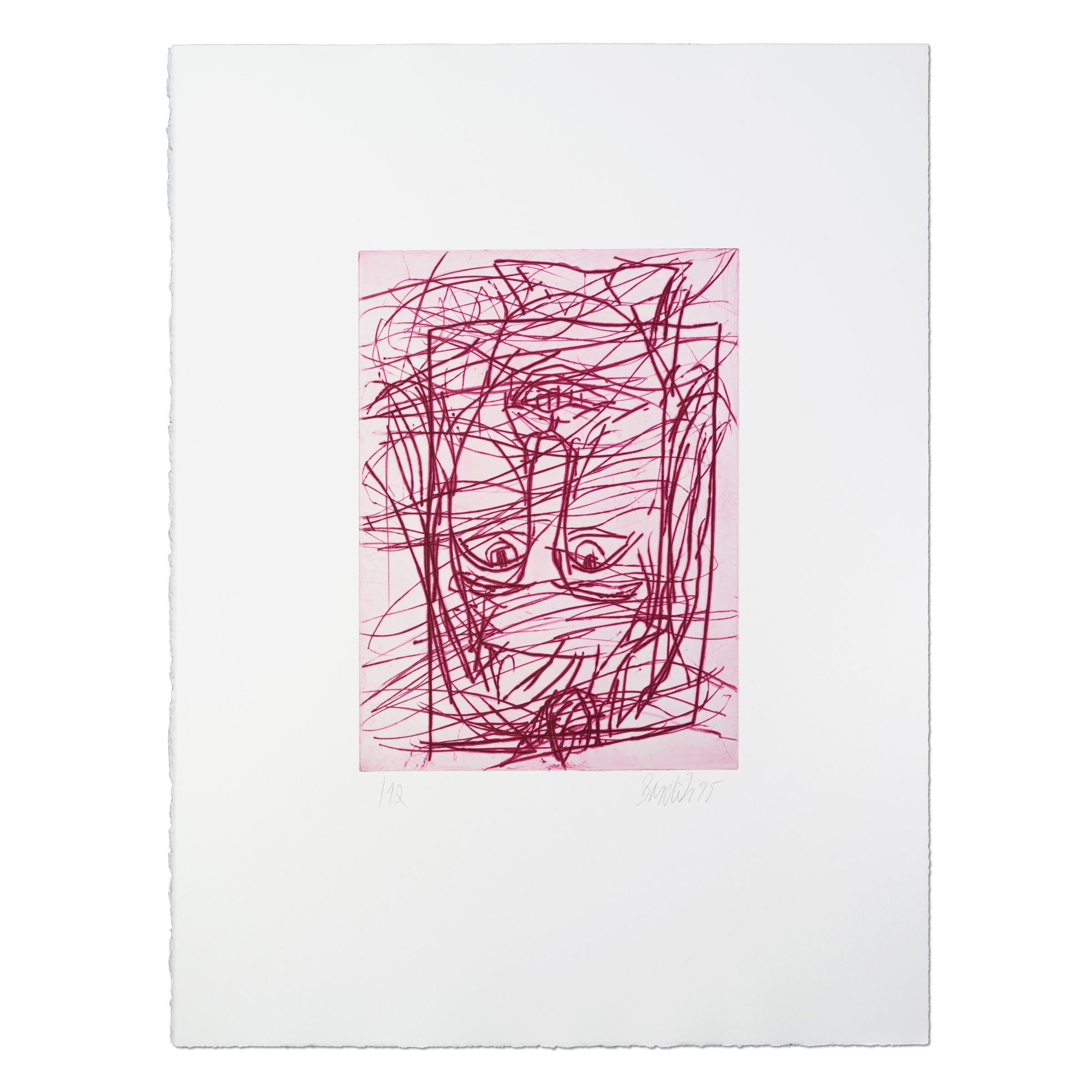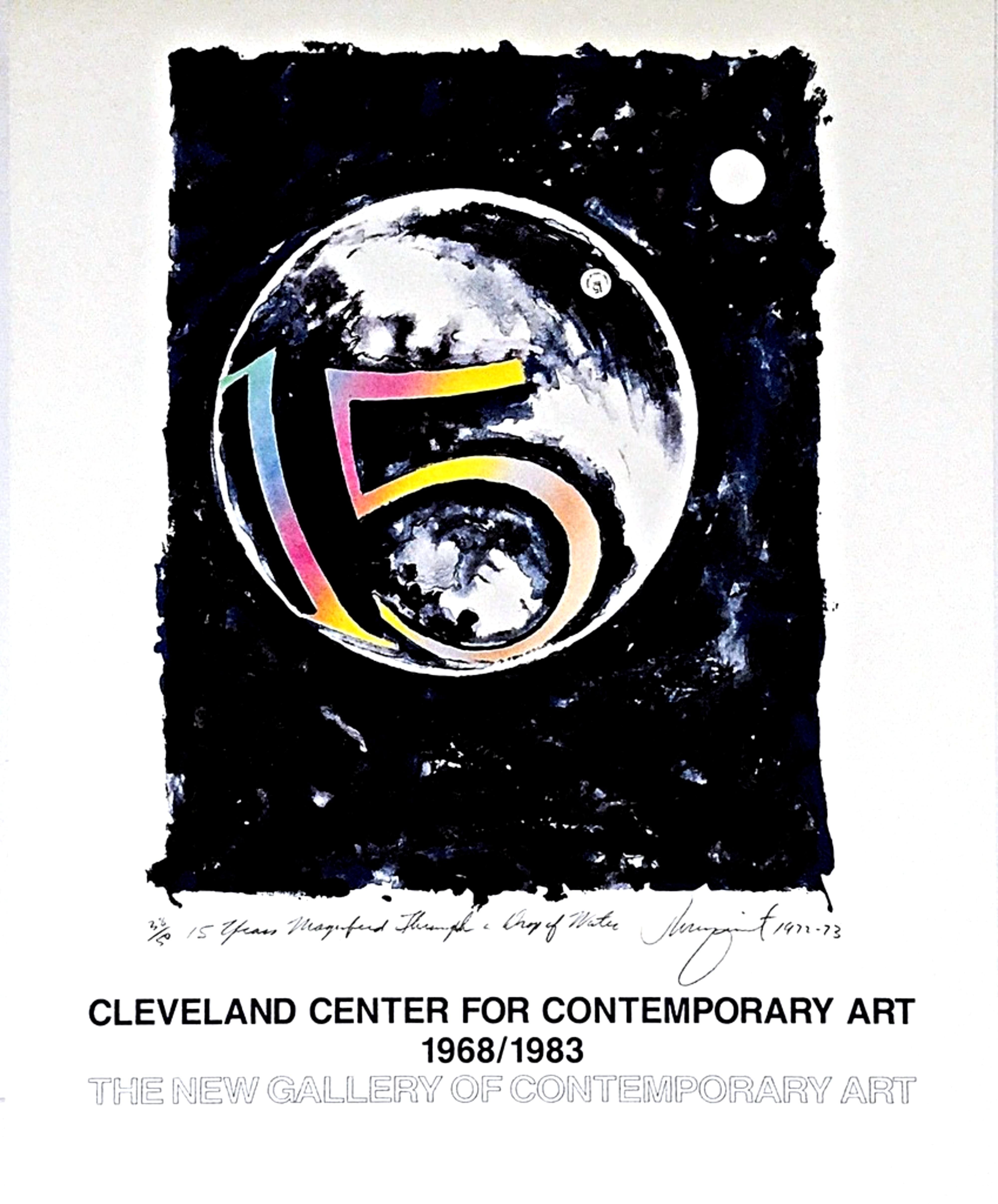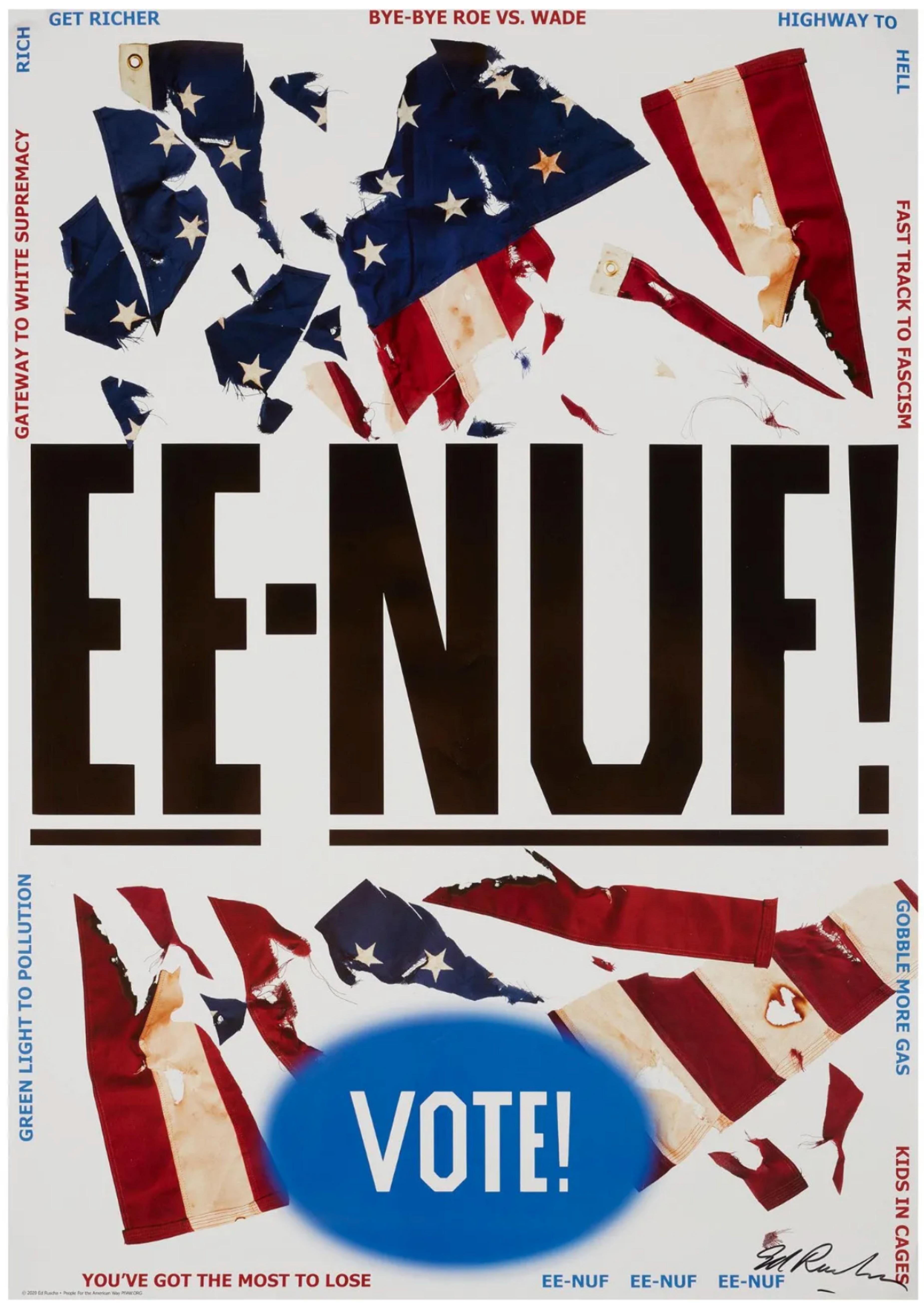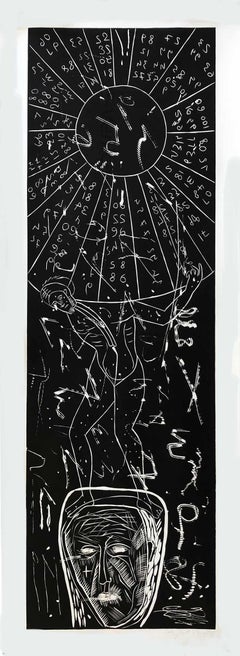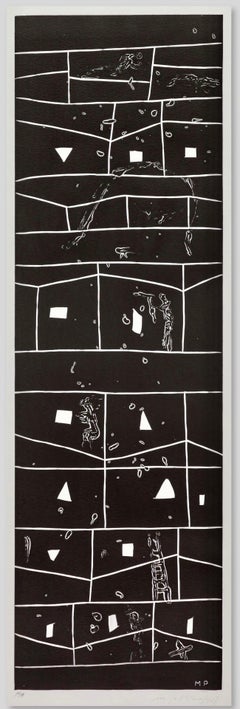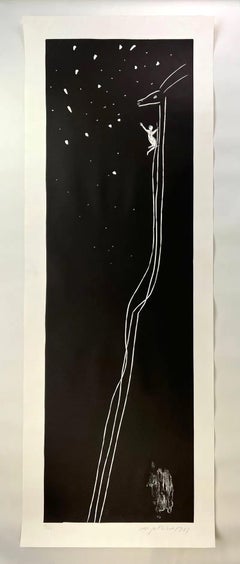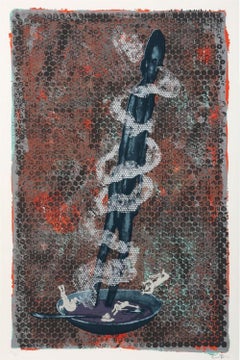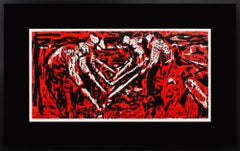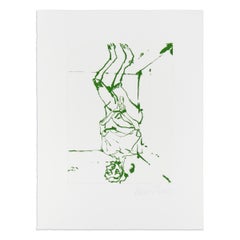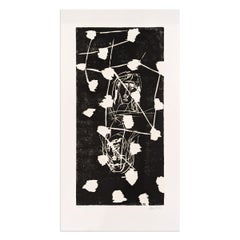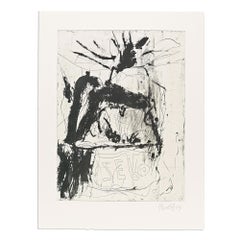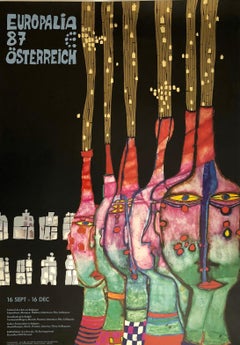
Vintage Europalia 87 Osterreich Metal Foil Print Offset Lithograph Poster
View Similar Items
Want more images or videos?
Request additional images or videos from the seller
1 of 9
Friedensreich HundertwasserVintage Europalia 87 Osterreich Metal Foil Print Offset Lithograph Poster1987
1987
About the Item
- Creator:Friedensreich Hundertwasser (1928-2000, Austrian)
- Creation Year:1987
- Dimensions:Height: 33 in (83.82 cm)Width: 23.5 in (59.69 cm)
- Medium:
- Movement & Style:
- Period:
- Condition:minor wear.
- Gallery Location:Surfside, FL
- Reference Number:1stDibs: LU38213259752
Friedensreich Hundertwasser
Friedensreich Hundertwasser (1928 – 2000) was an Austrian-born New Zealand artist and architect who worked also in the field of environmental protection. His real name being Stowasser, his pseudonym Hundertwasser (by which he is known worldwide) comes from "sto" in Slavic languages, meaning "hundred". He stood out as an opponent of "a straight line" and any standardization, expressing this concept in the field of building design. His best known work is considered Hundertwasserhaus in Vienna, Austria which has become a notable place of interest in the Austrian capital characterized by imaginative vitality and uniqueness.
About the Seller
4.9
Platinum Seller
Premium sellers with a 4.7+ rating and 24-hour response times
Established in 1995
1stDibs seller since 2014
1,752 sales on 1stDibs
Typical response time: 1 hour
Authenticity Guarantee
In the unlikely event there’s an issue with an item’s authenticity, contact us within 1 year for a full refund. DetailsMoney-Back Guarantee
If your item is not as described, is damaged in transit, or does not arrive, contact us within 7 days for a full refund. Details24-Hour Cancellation
You have a 24-hour grace period in which to reconsider your purchase, with no questions asked.Vetted Professional Sellers
Our world-class sellers must adhere to strict standards for service and quality, maintaining the integrity of our listings.Price-Match Guarantee
If you find that a seller listed the same item for a lower price elsewhere, we’ll match it.Trusted Global Delivery
Our best-in-class carrier network provides specialized shipping options worldwide, including custom delivery.More From This Seller
View AllHuge Italian Neo Expressionist Mimmo Paladino Linoleum Block Print Atlantico
By Mimmo Paladino
Located in Surfside, FL
Mimmo Paladino
Atlantico
Linocut, 1987, hand signed, dated and numbered 12/27 in pencil.
Medium: Collagraph and linoleum cut
Sheet measures 82 x 29 1/2" inches
Parole Torchon pap...
Category
1980s Neo-Expressionist Abstract Prints
Materials
Linocut
Huge Italian Neo Expressionist Mimmo Paladino Linoleum Block Print Atlantico
By Mimmo Paladino
Located in Surfside, FL
Mimmo Paladino
Atlantico
Linocut, 1987, hand signed, dated and numbered 12/27 in pencil.
Medium: Collagraph and linoleum cut
Sheet measures 82 x 29 1/2" inches
Parole Torchon pap...
Category
1980s Neo-Expressionist Abstract Prints
Materials
Linocut
Huge Italian Neo Expressionist Mimmo Paladino Linoleum Block Print Atlantico
By Mimmo Paladino
Located in Surfside, FL
Mimmo Paladino
Atlantico
Linocut, 1987, hand signed, dated and numbered 12/27 in pencil.
Medium: Collagraph and linoleum cut
Sheet measures 82 x 29 1/2" inches
Parole Torchon pap...
Category
1980s Neo-Expressionist Abstract Prints
Materials
Linocut
Large Silkscreen Serigraph Neo Figurative Expressionist Print Jorg Immendorff
By Jörg Immendorf
Located in Surfside, FL
Jorg Immendorff (German, 1945-2007)
Untitled, Germany, 2006
serigraph
hand signed and dated lower right margin, numbered 20/27 lower left
framed
74.5 x 48.75 inches (sight).
82.25 x 55.5 inches (frame).
This work is number 20 from the edition of 27.
Provenance: T. Kreuzer Gallery, Cologne, Friedman Benda Gallery, New York City
Jörg Immendorff (1945–2007) was a German painter, sculptor, stage designer and art professor. He was a member of the art movement Neue Wilde. He worked as a painter, sculpture and print maker in steel, bronze, oil painting, lithography etching and serigraphy.
Immendorff was born in Bleckede, Lower Saxony, near Lüneburg on the west bank of the Elbe. He attended the boarding School Ernst-Kalkuhl Gymnasium as a student. At the age of sixteen he had his first exhibition in a jazz hall cellar in Bonn.
Beginning in 1963, Immendorff studied at the Art Academy in Düsseldorf (Kunstakademie Düsseldorf). Initially he studied for three terms with the theater designer Teo Otto. After Otto threw him out of his class for refusing to let one of his paintings serve as stage-set decoration, Immendorff was accepted as a student by Joseph Beuys. The academy expelled him because of some of his (left-wing) political activities and neo-dada actions.
From 1969 to 1980, Immendorff worked as an art teacher at a public school, and then as a free artist, holding visiting professorships all over Europe. In 1989, he became professor at the Städelschule in Frankfurt am Main and in 1996 he became professor at the Art Academy in Düsseldorf—the same school that had dismissed him decades earlier as a student.
Jörg Immendorff often worked in "grand cycles of paintings" that often lasted years at a time and were political in nature. Notable cycles include LIDL, Maoist Paintings, Cafè Deutschland , and The Rake's Progress. The first body of work that Immendorff gave a name to were his LIDL paintings, sculptures, performances, and documents, that he executed during 1968-1970. The name, "LIDL" was inspired by the sound of a child's rattle makes and much of his work from this period included the iconography of new beginnings and innocence. LIDL is comparable to Dadaist but unlike the Dada movement it never became an established group but rather consisted of a variety of artists (including James Lee Byars, Marcel Broodthaers, Nam June Paik, and Joseph Beuys) participating in actions and activities.
In January 1968 he appeared in front of the West German Parliament in Bonn with a wood block labeled “Lidl” tethered to his ankle and painted in the colors of the German flag; he was subsequently arrested for defaming the flag.
Best known is his Cafe Deutschland series of sixteen large paintings (1977–1984) that were inspired by Renato Guttuso Caffè Greco; in these crowded colorful pictures, Immendorff had disco-goers symbolize the conflict between East and West Germany. Since the 1970s, he worked closely with the painter A. R. Penck from Dresden (in East Germany).
Immendorff created several stage designs, including two for the Salzburg Theater Festival. He designed sets for the operas Elektra and The Rake's Progress. The latter also inspired a series of paintings in which he cast himself as the rake.
In 1984, Immendorff opened the bar La Paloma near the Reeperbahn in Hamburg St. Pauli and created a large bronze sculpture of Hans Albers there. He also contributed to the design of Andre Heller's avant-garde amusement park "Luna, Luna" in 1987. Immendorff created various sculptures; one spectacular example is a 25 m tall iron sculpture in the form of an oak tree trunk, erected in Riesa in 1999. In 2006, Immendorff selected 25 of his paintings for an illustrated Bible. In the foreword he described his belief in God.
A major 2019 survey began at the Haus der Kunst in Munich and later traveled later to the Museo Reina Sofía in Madrid and the Fondazione Querini Stampalia in Venice, curated by Francesco Bonami. In 2000, Immendorff married his former student Oda Jaune. The have one daughter Ida Immendorff. He was a member of the Junge Wilde (German for "young wild ones")
In 1978, the Junge Wilde painting style arose in the German-speaking world in opposition to established avant garde, minimal art and conceptual art. It was linked to the similar Transavanguardia movement in Italy, USA (neo-expressionism) and France (Figuration Libre). The Junge Wilde painted their expressive paintings in bright, intense colors and with quick, broad brushstrokes very much influenced by Professor at the Academy of Art in Berlin, Karl Horst Hödicke (b:1938). They were sometimes called the Neue Wilde. Berlin: Luciano...
Category
Early 2000s Neo-Expressionist Abstract Prints
Materials
Screen
French Modernist Mourlot Lithograph Vintage Air France Poster Roger Bezombes
By Roger Bezombes
Located in Surfside, FL
Vintage French Travel Poster, Air france
Roger Bezombes
(1913-1994) French
Bezombes was a painter, sculptor, medalist, and designer. He studied in Paris, at the École des Beaux-Arts, and was much influenced by his friendship with Maurice Denis. Heavily influenced by surrealism, He worked principally as a painter, adopting the saturated Fauvist colors of Henri Matisse in landscapes and figure studies often based on observation of “exotic” cultures, notably Mediterranean and North African. Constrained, because a very young orphan, to all kinds of professions which provide him with the material means to devote himself to painting - he participated in 1930 in the installation of the exhibition of the Bauhaus at the Grand Palais-, Roger Bezombes is student of the National School of Fine Arts in Paris. (Ecole des Beaux Artes) He was trained in the art of fresco by Paul Baudoüin, René Barotte nonetheless restores that the young man's preference goes to the practice of "truancy" which he uses to make copies at the Louvre Museum. It’s the time when Paul Gauguin’s paintings, Vincent Van Gogh and Henri Matisse are revealed to him by Maurice Denis with whom he will remain close until his accidental death, painting him on his funeral bed on November 14, 1943. He executed surrealist tapestry designs for Aubusson and Gobelin tapestries, posters (winning the Grand Prix de l'Affiche Francaise in 1984), costumes and sets for ballets at the Metropolitan Opera House in New York, reliefs and murals. In 1965 he took up medal-making, expressing in his numerous metallic works for the Paris Mint that obsession with found objects which is also evident in his large-scale sculpture and in his posters.
He designed posters for Air France and for the French national railways.
Roger Bezombes went to Africa for the first time in 1936 thanks to a travel grant and received the same year the second grand prize of Rome . In 1937 he traveled around Morocco where he became friends with Albert Camus. The year 1938 offered him both his first solo exhibition at the Charpentier gallery in Paris with paintings and gouaches on the theme of Morocco and the attribution of the national grand prize for the arts, earning him a great journey which , from Dakar to Algiers , takes it through Chad , Tamanrasset and Hoggar.
Roger Bezombes became a professor at the Julian Academy in 1950. For him, 1951 was the year of a trip to Greece and the year where he began his relationship with tapestry work.
Roger Bezombes visited Israel in 1953, Tunisia and Egypt in 1954. He was appointed official painter of the Navy in 1955. Pierre Mazars analyzes that “after a period where we notice the influence of Van Gogh and GeorgesBraque, particularly in his landscapes of Provence, he came to a more schematic writing, the colored spots and the thicknesses of material taking more of importance as the subject. He even performed composite works, half-watercolors, half-pasted papers, in which he incorporated pieces of newspapers”. He was elected titular to the Academy of Overseas Sciences in 1978. "The range of Bezombes' talent forms is remarkable,” writes Lynne Thornton, “ranging from paintings, murals, travel posters, tapestry cartons, book illustrations, monumental ceramic decorations, ballet and theater sets, totem sculptures, sculpture objects, jewelry and medallions”. He was part of the mid century mod School of Paris that included Leon Zack, Bernard Lorjou, Paul Augustin Aizpiri, Gabriel Godard, Michel Henry, Hans Erni, Bengt Lindstrom, Alfred Manessier, Andre Hambourg, Raymond Legueult and Jean Rigaud.
Select Solo Exhibitions:
1938: Galerie Charpentier, Paris
1950, '53, '55, '57: Galerie Andre Weil, Paris
1953:Wildenstein Gallery, London
1954: Institut Francais, Cologne
1956: Galerie Matarasso, Nice
1957: Horn Gallery, Luxembourg; Guilde de la Gravure, Paris
1958: Denys-Puech Museum, Rodez
1962: Musee de l'Athenee, Geneva;
Chateau Grimaldi, Cagnes-sur-Mer
1966: Galerie des Ponchettes, Nice
1967: Galerie Martel, Montreal
1968: Romanet-Vercel Gallery, New York;
Reattu Museum, Arles; Le Corbusier Center, Firminy
1969: Galerie Philippe...
Category
1980s Modern Abstract Prints
Materials
Lithograph, Offset
French Modernist Mourlot Lithograph Vintage Air France Poster Roger Bezombes
By Roger Bezombes
Located in Surfside, FL
Vintage French Travel Poster, Air France
Roger Bezombes
(1913-1994) French
Bezombes was a painter, sculptor, medalist, and designer. He studied in Paris, at the École des Beaux-Arts, and was much influenced by his friendship with Maurice Denis. Heavily influenced by surrealism, He worked principally as a painter, adopting the saturated Fauvist colors of Henri Matisse in landscapes and figure studies often based on observation of “exotic” cultures, notably Mediterranean and North African. Constrained, because a very young orphan, to all kinds of professions which provide him with the material means to devote himself to painting - he participated in 1930 in the installation of the exhibition of the Bauhaus at the Grand Palais-, Roger Bezombes is student of the National School of Fine Arts in Paris. (Ecole des Beaux Artes) He was trained in the art of fresco by Paul Baudoüin, René Barotte nonetheless restores that the young man's preference goes to the practice of "truancy" which he uses to make copies at the Louvre Museum. It’s the time when Paul Gauguin’s paintings, Vincent Van Gogh and Henri Matisse are revealed to him by Maurice Denis with whom he will remain close until his accidental death, painting him on his funeral bed on November 14, 1943. He executed surrealist tapestry designs for Aubusson and Gobelin tapestries, posters (winning the Grand Prix de l'Affiche Francaise in 1984), costumes and sets for ballets at the Metropolitan Opera House in New York, reliefs and murals. In 1965 he took up medal-making, expressing in his numerous metallic works for the Paris Mint that obsession with found objects which is also evident in his large-scale sculpture and in his posters.
He designed posters for Air France and for the French national railways.
Roger Bezombes went to Africa for the first time in 1936 thanks to a travel grant and received the same year the second grand prize of Rome . In 1937 he traveled around Morocco where he became friends with Albert Camus. The year 1938 offered him both his first solo exhibition at the Charpentier gallery in Paris with paintings and gouaches on the theme of Morocco and the attribution of the national grand prize for the arts, earning him a great journey which , from Dakar to Algiers , takes it through Chad , Tamanrasset and Hoggar.
Roger Bezombes became a professor at the Julian Academy in 1950. For him, 1951 was the year of a trip to Greece and the year where he began his relationship with tapestry work.
Roger Bezombes visited Israel in 1953, Tunisia and Egypt in 1954. He was appointed official painter of the Navy in 1955. Pierre Mazars analyzes that “after a period where we notice the influence of Van Gogh and GeorgesBraque, particularly in his landscapes of Provence, he came to a more schematic writing, the colored spots and the thicknesses of material taking more of importance as the subject. He even performed composite works, half-watercolors, half-pasted papers, in which he incorporated pieces of newspapers”. He was elected titular to the Academy of Overseas Sciences in 1978. "The range of Bezombes' talent forms is remarkable,” writes Lynne Thornton, “ranging from paintings, murals, travel posters, tapestry cartons, book illustrations, monumental ceramic decorations, ballet and theater sets, totem sculptures, sculpture objects, jewelry and medallions”. He was part of the mid century mod School of Paris that included Leon Zack, Bernard Lorjou, Paul Augustin Aizpiri, Gabriel Godard, Michel Henry, Hans Erni, Bengt Lindstrom, Alfred Manessier, Andre Hambourg, Raymond Legueult and Jean Rigaud.
Select Solo Exhibitions:
1938: Galerie Charpentier, Paris
1950, '53, '55, '57: Galerie Andre Weil, Paris
1953:Wildenstein Gallery, London
1954: Institut Francais, Cologne
1956: Galerie Matarasso, Nice
1957: Horn Gallery, Luxembourg; Guilde de la Gravure, Paris
1958: Denys-Puech Museum, Rodez
1962: Musee de l'Athenee, Geneva;
Chateau Grimaldi, Cagnes-sur-Mer
1966: Galerie des Ponchettes, Nice
1967: Galerie Martel, Montreal
1968: Romanet-Vercel Gallery, New York;
Reattu Museum, Arles; Le Corbusier Center, Firminy
1969: Galerie Philippe...
Category
1980s Modern Abstract Prints
Materials
Lithograph, Offset
You May Also Like
"Fieldwork" Large 5+-Foot Original Woodcut on Paper by Roger Herman, Framed
By Roger Herman
Located in Encino, CA
"Fieldwork," an original woodcut on paper by Roger Herman, is a piece for the true collector. This spectacular woodcut cannot be properly communicated digitally – it is a far more impactful and meaningful experience in person. This work of art would definitely enhance most homes or professional settings, perfect for those who have an affinity for abstracts, Neo-Expressionism, modernist paintings, or postmodern art. This woodcut was printed by Hans-Fuss and published by the Graphic Arts Council at LACMA. Work is outfitted with custom, conservation frame.
Art historian Howard Singerman's words from the December 1982 ArtForum Magazine:
"...Herman's expressionistic style... with its roots in German Expressionism and the New York School, is previously painted. His mean colors, thick pigment, and quick strokes are not a direct record of emotion and activity, they are not painting outside language, but signs for that painting, for an emotion and an activity that are no longer available. The expressionist act is recast as romantic aspiration; in his inscription, Herman evokes painting's past and admits his need for its aura...
...Herman's distance even undermines the emblematic immediacy of his expressionism, which he uses to attain more distance still. Unlike the flattened, aggressive figures that push to, and threaten to push through, the surfaces of most new painting, Herman's figures are situated in middle ground and buried beneath the paint..."
Artist: ROGER HERMAN (1947-)
Title: FIELDWORK
Medium & Surface: ORIGINAL WOODCUT ON PAPER (framed)
Signed/Numbered: HAND-SIGNED, NUMBERED, AND TITLED BY ARTIST
Number: 36 of 75
Year Created: 1984
Country of Creation: UNITED STATES
Image Area Dimensions: 24 x 48 INCHES
Paper Dimensions: 38 x 62 INCHES
Frame Dimensions:* 41.25 x 65.25 x 1 INCHES
*This work of art is being sold framed. If you would like to change the frame to better match your style or environment, please contact us for Custom Archival Framing options.
Additional Info: HIGHLY COLLECTIBLE WORK BY ROGER HERMAN – PRINTED BY HANS-FUSS WITH BLIND STAMP LOWER RIGHT. PUBLISHED BY THE GRAPHIC ARTS COUNCIL AT LACMA. FEATURES CUSTOM CONSERVATION FRAME.
Artist Info/Bio: ARTIST BIOGRAPHY DOCUMENT IS INCLUDED
Documentation: CERTIFICATE OF AUTHENTICITY IS INCLUDED
About the Artist: Roger Herman, a German painter and ceramic artist, has become well known for the broad range of styles encompassed within his work across multiple mediums.
Roger Herman was born in Germany in 1947, where he began his studies at the Kunstakademie in Karlsruhe. In 1976, he was offered a fellowship from the German Academic Exchange Service (DAAD), which took him across the world to San Francisco. It was here, in California, that his career began to flourish.
He started by creating paintings of phenomenal proportion, soon christened as the West Coast parallel of the 80s Neo-expressionist movement. It was highly referential work, drawing on his knowledge of art history, as well as his famed sense of humor. With loose, facile brushwork, his art is reminiscent of the figurative German painters who emerged in the 1970s—like Markus Lüpertz (who taught at the Kunstakademie), Rainer Fetting...
Category
1980s Neo-Expressionist Abstract Prints
Materials
Woodcut
$1,600 Sale Price
70% Off
Georg Baselitz, Serpentine (Green) - Original Etching, Signed Print
By Georg Baselitz
Located in Hamburg, DE
Georg Baselitz (German, b. 1938)
Serpentine (Green), 2022
Medium: Etching with sugar lift aquatint on wove paper
Dimensions: 53 × 39 cm (20 9/10 × 15 2/5 in)
Edition of 50: Hand-sign...
Category
21st Century and Contemporary Neo-Expressionist Figurative Prints
Materials
Etching
Georg Baselitz, 45 – August: Woodcut on Paper from 1990, Signed Print
By Georg Baselitz
Located in Hamburg, DE
Georg Baselitz (German, born 1938)
45 – August, 1990
Medium: Woodcut on paper
Dimensions: 124.2 x 68 cm
Edition of 30: Hand-signed, numbered and dated in pencil
Condition: Excellent
Category
20th Century Neo-Expressionist Abstract Prints
Materials
Woodcut
Georg Baselitz, Farewell Bill #7 - Signed Print, Edition of 15, Abstract Art
By Georg Baselitz
Located in Hamburg, DE
Georg Baselitz (German, b. 1938)
Untitled #7 (from Farewell Bill), 2013
Medium: Aquatint and line etching on wove paper
Dimensions: 85.1 x 64.9 cm
Edition of 15: Hand-signed and numb...
Category
21st Century and Contemporary Neo-Expressionist Abstract Prints
Materials
Etching, Aquatint
Georg Baselitz, Farewell Bill #4 - Signed Print, Edition of 15, Abstract Art
By Georg Baselitz
Located in Hamburg, DE
Georg Baselitz (German, b. 1938)
Untitled #4 (from Farewell Bill), 2013
Medium: Aquatint and line etching on wove paper
Dimensions: 85.1 x 64.9 cm
Edition of 15: Hand-signed and numb...
Category
21st Century and Contemporary Neo-Expressionist Abstract Prints
Materials
Etching, Aquatint
Georg Baselitz, Schwester Rosi III - Signed Print, Contemporary Art
By Georg Baselitz
Located in Hamburg, DE
Georg Baselitz (German, b. 1938)
Schwester Rosi III, 1995/1996
Medium: Drypoint etching on wove paper
Dimensions: 80 x 60 cm
Edition of 12: Hand-signed and numbered
Condition: Excellent
Category
20th Century Neo-Expressionist Figurative Prints
Materials
Drypoint, Etching
